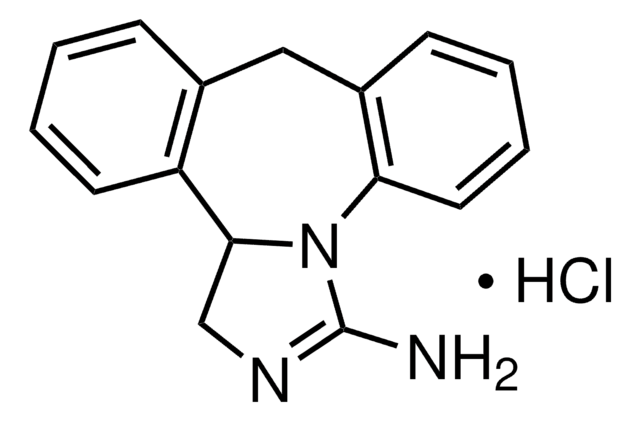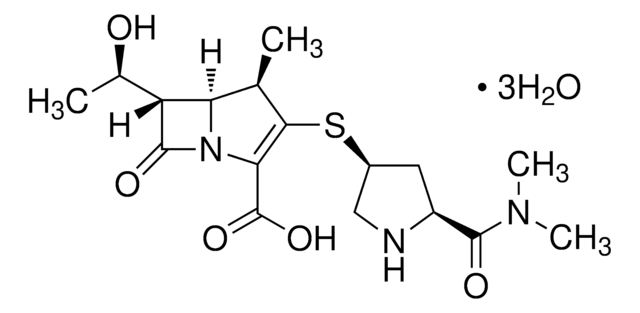おすすめの製品
グレード
pharmaceutical primary standard
APIファミリー
epinastine
メーカー/製品名
EDQM
アプリケーション
pharmaceutical (small molecule)
フォーマット
neat
保管温度
2-8°C
SMILES記法
Cl[H].NC1=NCC2N1c3ccccc3Cc4ccccc24
InChI
1S/C16H15N3.ClH/c17-16-18-10-15-13-7-3-1-5-11(13)9-12-6-2-4-8-14(12)19(15)16;/h1-8,15H,9-10H2,(H2,17,18);1H
InChI Key
VKXSGUIOOQPGAF-UHFFFAOYSA-N
遺伝子情報
human ... HRH1(3269)
類似した製品をお探しですか? 訪問 製品比較ガイド
詳細
この製品は薬局方標準品です。発行元の薬局方により製造・供給されています。MSDSを含む製品情報などの詳しい情報は、発行元の薬局方のウェブサイトよりご確認ください。
アプリケーション
Epinastine hydrochloride EP Reference standard, intended for use in laboratory tests only as specifically prescribed in the European Pharmacopoeia.
生物化学的/生理学的作用
Epinastine hydrochloride is a non-sedating H1 histamine receptor antagonist.
包装
The product is delivered as supplied by the issuing Pharmacopoeia. For the current unit quantity, please visit the EDQM reference substance catalogue.
その他情報
Sales restrictions may apply.
シグナルワード
Danger
危険有害性情報
危険有害性の分類
Acute Tox. 3 Oral
保管分類コード
6.1C - Combustible acute toxic Cat.3 / toxic compounds or compounds which causing chronic effects
WGK
WGK 3
引火点(°F)
Not applicable
引火点(℃)
Not applicable
適用法令
試験研究用途を考慮した関連法令を主に挙げております。化学物質以外については、一部の情報のみ提供しています。 製品を安全かつ合法的に使用することは、使用者の義務です。最新情報により修正される場合があります。WEBの反映には時間を要することがあるため、適宜SDSをご参照ください。
Jan Code
Y0001139:
Y0001139-20MG:
Y0001139-1EA:
最新バージョンのいずれかを選択してください:
Rosaly Vieira dos Santos et al.
Annals of allergy, asthma & immunology : official publication of the American College of Allergy, Asthma, & Immunology, 102(6), 495-499 (2009-06-30)
Nonsedating antihistamines (nsAHs) are recommended as first-line therapeutics for the treatment of mast cell-driven disorders, including allergic rhinitis and urticaria. However, their superiority over first-generation AHs (fgAHs) has recently been called into question, mainly because of the lack of supporting
Kelly K Nichols et al.
Eye & contact lens, 35(1), 26-31 (2009-01-07)
To assess the comfort and efficacy of epinastine 0.05% ophthalmic solution in contact lens wearers with a history of allergic conjunctivitis and contact lens intolerance during allergy season. One hundred forty-six subjects were enrolled in a multicenter, open-label study. Enrolled
Gail L Torkildsen et al.
Clinical therapeutics, 30(7), 1264-1271 (2008-08-12)
The aim of this study was to compare short-term (5-minute) ocular comfort and drying effects of 3 topical antihistamine/mast cell stabilizers-epinastine, azelastine, and ketotifen-in patients with allergic conjunctivitis (AC). Adults with a history of AC, as confirmed on skin testing
Paramdeep S Bilkhu et al.
Ophthalmology, 121(1), 72-78 (2013-09-28)
To investigate whether artificial tears and cold compress alone or in combination provide a treatment benefit and whether they were as effective as or could enhance topical antiallergic medication. Randomized, masked clinical trial. Eighteen subjects (mean age, 29.5±11.0 years) allergic
Halifu Yilinuer et al.
Archives of dermatological research, 302(1), 19-26 (2009-11-26)
The itch-scratch cycle aggravates chronic inflammatory skin diseases. We have previously reported that mice begin to scratch themselves within several minutes after skin-scratching stimulation. This is associated with an increase in release of substance P (SP) from sensory nerve fibers
ライフサイエンス、有機合成、材料科学、クロマトグラフィー、分析など、あらゆる分野の研究に経験のあるメンバーがおります。.
製品に関するお問い合わせはこちら(テクニカルサービス)






